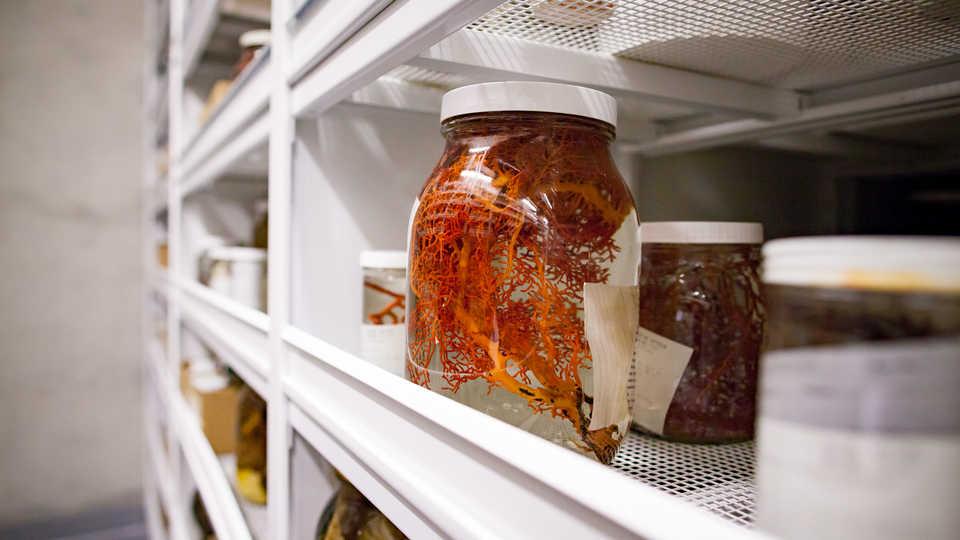A team of scientists says funding taxonomy and natural history museum collections is key to better understanding life on Earth
SAN FRANCISCO (September 5, 2019)—There’s more to most natural history museums than meets the eye. In response to a June Science story covering a new multimillion-dollar global effort to identify two million new species using DNA sequencing, a team of scientists from the California Academy of Sciences and partner institutions are calling for support of the best resource for understanding life on Earth: natural history museum collections. Chronically underfunded yet full of treasures, these museum collections—typically held behind-the-scenes in large custom store rooms—are estimated to hold thousands of undescribed species awaiting identification and in need of specialized care. The team’s article and call-to-action is published in Science.
“The massive gap in our taxonomic knowledge isn’t a problem of finding new species in the wild, but a lack of support and experts to formally describe them,” says first author Dr. Hudson Pinheiro, Academy research associate and reef fish expert. “There’s an average shelf life of 21 years between the moment a new species is discovered and its formal scientific description. The only way to work through the backlog and speed up descriptions is to increase funding to the field of taxonomy and museum collections, and train new experts.”
Biodiversity scientists estimate that we’ve discovered less than ten percent of Earth’s species, but many are left unknown both in the field and within museum collections. One route to species discovery begins when scientists apply for permits and travel to collect wild plants, animals, or fungi around the world. After arriving at a natural history collection for preservation and research, these delicate specimens—kept in climate-controlled cases, jars, and cabinets—require special care in order to be available for longterm study. When highly trained researchers describe a new species, they use DNA analyses in addition to information from the specimens’ anatomy, biology, ecology, and comparisons to other similar organisms (some centuries-old, or fossilized) on file in global scientific collections. It takes time, resources, and staff to describe specimens from the field, accounting for long average “undescribed” shelf lives within museum collections.
“Large scale DNA sequencing may add millions of new discoveries to the already-large backlog of species awaiting description, so to make a difference, funders must also support taxonomy,” says coauthor Dr. Luiz Rocha, Academy curator of fishes and co-leader of its Hope for Reefs initiative. “Each new species discovery may hold the key to groundbreaking innovations in science, technology, or society, and helps us better understand life on our changing planet. But the first step in this process is always a formal taxonomic description, so we should also invest in our field’s greatest challenges in specimen care, long term collection support, and training the next generation of passionate experts.”
The authors say the lack of investment in natural history collections and research worldwide is clear, and especially apparent in developing countries that hold most of the planet’s biodiversity. “Many new species that might be at risk of extinction in nature,” the article states, “have the same risk of disappearing from museum shelves due to the lack of maintenance. DNA barcodes alone are not enough to document the biological diversity.”
“It’s past time for governments, societies, and institutions to invest meaningfully in taxonomists, collections, and their staff,” adds Rocha. “A deeper understanding of life on Earth and a new generation of science experts will help us build a more sustainable future.”
The Institute for Biodiversity Science and Sustainability at the California Academy of Sciences is at the forefront of efforts to understand two of the most important topics of our time: the nature and sustainability of life on Earth. Based in San Francisco, the Institute is home to more than 100 world-class scientists, state-of-the-art facilities, and nearly 46 million scientific specimens from around the world. The Institute also leverages the expertise and efforts of more than 100 international Associates and 450 distinguished Fellows. Through expeditions around the globe, investigations in the lab, and analyses of vast biological datasets, the Institute’s scientists work to understand the evolution and interconnectedness of organisms and ecosystems, the threats they face around the world, and the most effective strategies for sustaining them into the future. Through innovative partnerships and public engagement initiatives, they also guide critical sustainability and conservation decisions worldwide, inspire and mentor the next generation of scientists, and foster responsible stewardship of our planet.
Press Contacts
If you are a journalist and would like to receive Academy press releases please contact press@calacademy.org.
Digital Assets
Hi-res and low-res image downloads are available for editorial use. Contact us at press@calacademy.org to request access.



